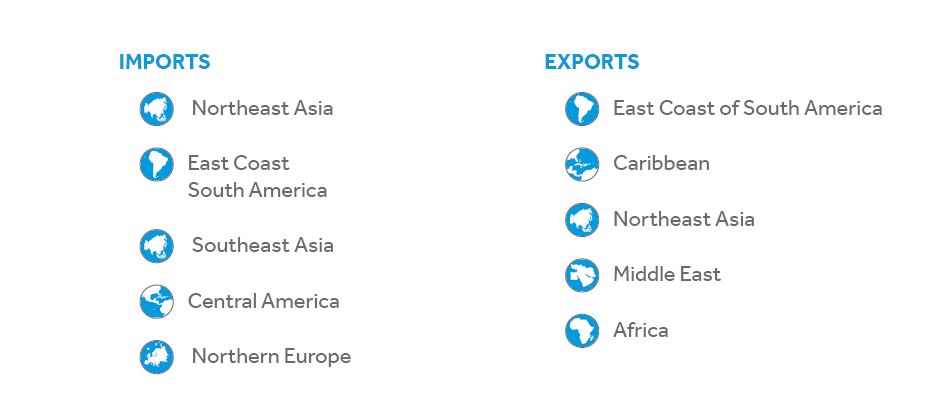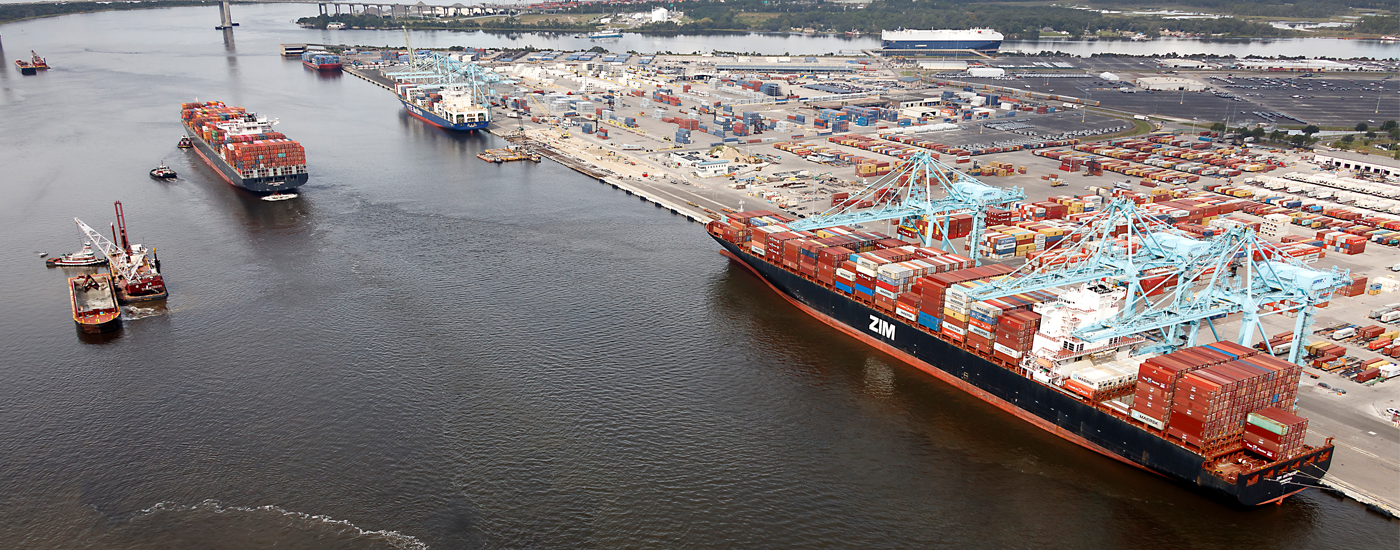Located in the heart of the Southeastern United States, at the crossroads of the nation’s rail and highway network, JAXPORT is a preferred global gateway to Florida, the nation’s third-most-populous state. JAXPORT is Florida’s largest container port by volume and one of the nation’s top vehicle-handling ports.
JAXPORT owns, maintains and markets three cargo terminals, two intermodal rail terminals and one passenger cruise terminal along the St. Johns River: Blount Island Marine Terminal, Dames Point Marine Terminal, Talleyrand Marine Terminal, Talleyrand Intermodal Container Transfer Facility (ICTF), Dames Point ICTF and JAXPORT Cruise Terminal.
The port’s single biggest growth initiative—deepening the Jacksonville shipping channel to 47 feet through the port’s Blount Island Marine Terminal—is anticipated to be complete in summer 2022, three years ahead of its original schedule. The deepening project includes construction of a vessel turning basin that allows larger ships to turn at Blount Island berths. More than $200 million in berth and terminal enhancements are currently underway to add container capacity and enable Blount Island to simultaneously accommodate two post-Panamax ships.
Dozens of ocean carriers call JAXPORT, offering shippers competitive transit times to 140 ports in more than 70 countries. JAXPORT offers ocean carrier services to all major world regions, including regular container service connecting Jacksonville with Asia, South America, the Caribbean and Central America, as well as customized container freight shipments and transshipment options to and from Europe and Africa. The world’s leading ocean carrier alliances call JAXPORT with regular services to destinations throughout Asia through both the Panama and Suez canals.
Port terminals are within minutes of three major Interstate highways – I-10, I-75 and I-95 – providing access to more than 98 million consumers within one day’s drive. JAXPORT is served by 100 trucking firms and 40 daily trains via Class I railroads CSX and Norfolk Southern and regional Florida East Coast Railway. JAXPORT’s intermodal connections offer seamless access to markets throughout the Southeast and Midwest, including Mississippi and Ohio river valleys. Northeast Florida offers numerous advantages for manufacturers, including 144 million square feet of competitively priced warehousing and distribution space, a labor force of 845,000-plus workers and streamlined clearances via Foreign-Trade Zone No. 64.
As one of the nation’s most diversified ports, JAXPORT has experienced labor for a variety of specialty cargos, including breakbulk, fresh and frozen, forest products, high and heavy, project cargo and more. Jacksonville is also a convenient, centrally located drive-to cruise market. The port is home to the 2,056-passenger Carnival Ecstasy, offering four- and five-day cruises to the Bahamas. The region is a global leader in the use of liquefied natural gas as a clean marine fuel. JAXPORT is the only U.S. East Coast port to offer on-dock and near-dock LNG fueling capabilities for ships, and four LNG-powered vessels are based in Jacksonville.
JAXPORT is Northeast Florida’s economic engine, with cargo activity through Jacksonville’s seaport supporting more than 26,000 jobs in Florida and more than $31 billion in annual economic output for the region and state.
Goals & Objectives
- The core strategies in JAXPORT’s Strategic Master Plan include growing JAXPORT’s container, auto and breakbulk business, as well as acquiring additional land to accommodate future growth.
- Historically, Puerto Rico is JAXPORT’s largest trading partner. We will continue to build on this important partnership, while growing our businesses throughout the Caribbean, as well as working to grow our offerings in the trans-Pacific, trans-Atlantic and African trades as well.
Current or Planned Investments
- Completion of Jacksonville Harbor Deepening Project to 47 feet.
- Container Terminal Upgrades at the SSA Jacksonville Container Terminal
- Westrock Property Development to expand cargo-handling capacity at the Talleyrand Marine Terminal.
Accomplishments
- Securing full funding for the 47-foot harbor deepening project and keeping the deepening ahead of schedule with a completion of summer 2022.
- Set a new container volume record and kept cargo moving seamlessly throughout the pandemic and the global supply chain crisis that followed.
- Grew private sector port-dependent jobs 8 percent over the previous 5-year period.
Hinterland
JAXPORT’s hinterland is primarily defined as the U.S. Southeast and Midwest. Jacksonville’s geographic location allows JAXPORT inbound cargo to reach 60 million consumers and 60 percent of the U.S. population within a one-day truck drive. The port is served by three dozen train departures daily. JAXPORT’s reach extends to all 48 contiguous states, according to the U.S. Department of Transportation’s study of destinations for imported goods.
Trade Partners

Mission
To contribute to the economic growth and vitality of Northeast Florida by fostering and stimulating commerce through the Port of Jacksonville. The mission will be accomplished through the effective and fiscally responsible planning, development, management and marketing of the port’s assets and facilities.

